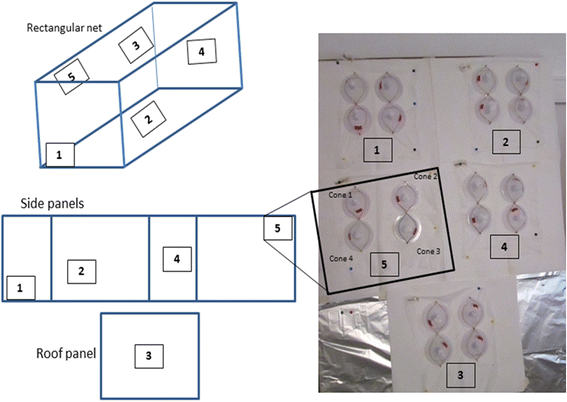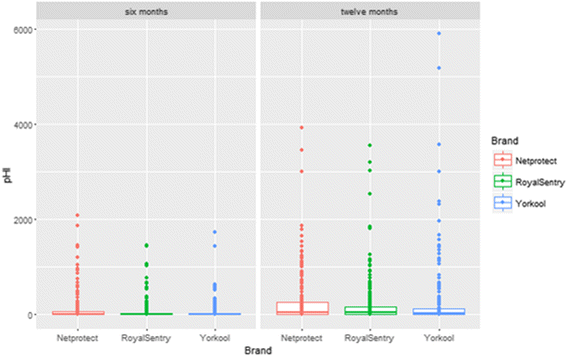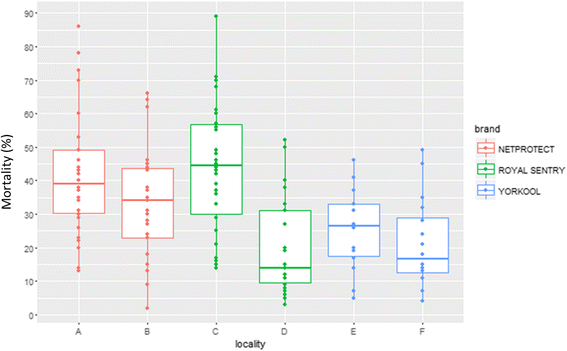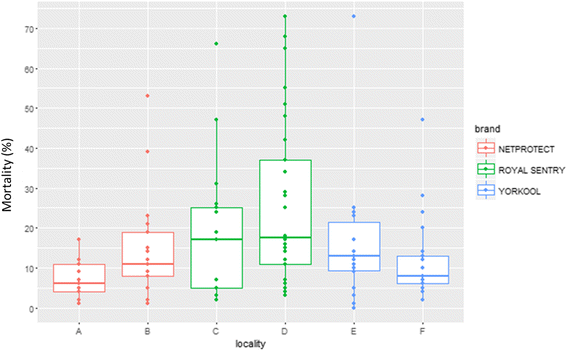Durability monitoring of long-lasting insecticidal (mosquito) nets (LLINs) in Madagascar: physical integrity and insecticidal activity
- PMID: 29132421
- PMCID: PMC5683549
- DOI: 10.1186/s13071-017-2419-7
Durability monitoring of long-lasting insecticidal (mosquito) nets (LLINs) in Madagascar: physical integrity and insecticidal activity
Abstract
Background: Long-lasting insecticidal mosquito nets (LLINs) are highly effective for malaria prevention. However, it is also clear that durability monitoring is essential to predict when, post-distribution, a net population, no longer meets minimum WHO standards and needs to be replaced. Following a national distribution campaign in 2013, we tracked two durability indicators, physical integrity and bio-efficacy at six and 12 months post-distribution. While the loss of net integrity during this period was in line with expectations for a one-year net life, bio-efficacy results suggested that nets were losing insecticidal effect faster than expected. The rate of bio-efficacy loss varied significantly between different net brands.
Methods: We tested 600 randomly selected LLINs, 200 from each of three net brands. Each brand came from different eco-epidemiological zones reflecting the original distribution scheme. Fabric integrity (size and number of holes) was quantified using the proportional hole index (pHI). A subsample of the nets, 134 new nets, 150 at six months and 124 at 12 months, were then tested for bio-efficacy using the World Health Organization (WHO) recommended method.
Results: Three net types, Netprotect®, Royalsentry® and Yorkool®, were followed. After six months, 54%, 39% and 45%, respectively, showed visible loss of integrity. The median pHI by type was estimated to be one, zero and one respectively. The percentage of damaged nets increased after 12 months such that 83.5%, 74% and 68.5%, had holes. The median pHI for each brand of nets was 47.5, 47 and 23. No significant difference in the estimated pHI at either six or 12 months was observed. There was a statistically significant difference in the proportion of hole size category between the three brands (χ 2 = 15.761, df = 4, P = 0.003). In cone bio-assays, mortality of new Yorkool® nets was surprisingly low (48.6%), mortality was 90.2% and 91.3% for Netprotect® and Royalsentry® (F (2, 131) = 81.59, P < 0.0001), respectively. At 12 month use, all tested nets were below the WHO threshold for replacement.
Conclusion: These findings suggest that there is a need for better net quality control before distribution. More frequent replacement of LLINs is probably not an option programmatically. Regardless of prior approval, LLIN durability monitoring for quality assessment as well as net loss following distribution is necessary to improve malaria control efforts.
Keywords: Bio-efficacy; Fabric integrity; Long-lasting insecticide-treated nets; Madagascar; Malaria.
Conflict of interest statement
Ethics approval and consent to participate
This study was reviewed by both CDC Atlanta and Madagascar local ethics board and was determined quality improvement that did not need ethical clearance. However, written informed consent was sought for participants in this study.
Consent for publication
Not applicable.
Competing interests
The authors declare that they have no competing interests.
Publisher’s Note
Springer Nature remains neutral with regard to jurisdictional claims in published maps and institutional affiliations.
Figures






Similar articles
-
Physical integrity and survivorship of long-lasting insecticidal nets distributed to households of the same socio-cultural community in Benin, West Africa.Malar J. 2020 Feb 4;19(1):58. doi: 10.1186/s12936-020-3138-7. Malar J. 2020. PMID: 32019586 Free PMC article.
-
A cross-sectional study assessing the residual bio-efficacy and durability of field-distributed long-lasting insecticidal nets in malaria endemic ethnic communities of Assam, Northeast India.J Infect Public Health. 2016 May-Jun;9(3):298-307. doi: 10.1016/j.jiph.2015.10.005. Epub 2015 Nov 15. J Infect Public Health. 2016. PMID: 26589658
-
Do long-lasting insecticidal nets retain their efficacy after three years of usage in Afghanistan? Findings from a study on survivorship, physical integrity, insecticidal activity and wash resistance.Malar J. 2025 Apr 15;24(1):121. doi: 10.1186/s12936-025-05346-1. Malar J. 2025. PMID: 40234878 Free PMC article.
-
Culminating anti-malaria efforts at long lasting insecticidal net?J Infect Public Health. 2014 Nov-Dec;7(6):457-64. doi: 10.1016/j.jiph.2014.06.002. Epub 2014 Aug 1. J Infect Public Health. 2014. PMID: 25092624 Review.
-
Quality Control of Long-Lasting Insecticidal Nets: Are We Neglecting It?Trends Parasitol. 2021 Jul;37(7):610-621. doi: 10.1016/j.pt.2021.03.004. Epub 2021 Mar 25. Trends Parasitol. 2021. PMID: 33773912 Review.
Cited by
-
LLIN Evaluation in Uganda Project (LLINEUP): factors associated with ownership and use of long-lasting insecticidal nets in Uganda: a cross-sectional survey of 48 districts.Malar J. 2018 Nov 13;17(1):421. doi: 10.1186/s12936-018-2571-3. Malar J. 2018. PMID: 30424775 Free PMC article.
-
Increasing the resolution of malaria early warning systems for use by local health actors.Malar J. 2025 Jan 30;24(1):30. doi: 10.1186/s12936-025-05266-0. Malar J. 2025. PMID: 39885540 Free PMC article.
-
Monitoring the durability of the long-lasting insecticidal nets MAGNet and Royal Sentry in three ecological zones of Mozambique.Malar J. 2020 Jun 17;19(1):209. doi: 10.1186/s12936-020-03282-w. Malar J. 2020. PMID: 32552819 Free PMC article.
-
Durability of long-lasting insecticidal nets (LLINs) in Ethiopia.Malar J. 2023 Mar 26;22(1):109. doi: 10.1186/s12936-023-04540-3. Malar J. 2023. PMID: 36967389 Free PMC article.
-
Using routine health data to evaluate the impact of indoor residual spraying on malaria transmission in Madagascar.BMJ Glob Health. 2023 Jul;8(7):e010818. doi: 10.1136/bmjgh-2022-010818. BMJ Glob Health. 2023. PMID: 37463785 Free PMC article.
References
-
- WHO. World malaria report. Geneva: World Health Organization. 2016:2016.
-
- Madagascar MIS. République de Madagascar Enquête sur les Indicateurs du Paludisme (EIPM) 2013.
-
- Chauvet G, Coz J, Gruchet H, Grjébine A, Lumaret R. Résultats de 5 années d'étude: Contribution à l’étude biologique des vecteurs du paludisme à Madagascar. Med Trop. 1964;24:27–44. - PubMed
-
- Fontenille D, Campbell GHI. Anopheles mascarensis a new malaria vector in Madagascar? Am J Trop Med Hyg. 1992;46:28–30. - PubMed
MeSH terms
Substances
LinkOut - more resources
Full Text Sources
Other Literature Sources
Medical
Miscellaneous

